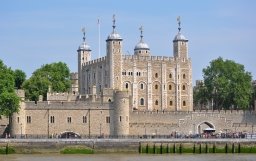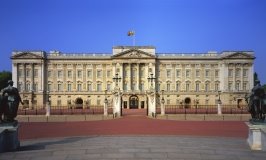Визначні місця Лондона
London’s Landmarks
The Teaching Aims:
- To develop monological skills;
- To activate lexical material on the topic;
- To practice using Present and Past Tenses; Passive Voice;
- To develop listening and reading comprehension skills;
- To improve speaking skills;
The Developing Aims:
- To develop students’ attention, memory and logical way of thinking;
- To promote students’ curiosity;
- To motivate and encourage students’cultural interest
The Upbringing Aims:
- To stimulate students’ thinking and discussion;
- To provide students with the information about London’s sights;
- To motivate students to learn more about London’s landmarks;
Equipment and visual aids:
- Pictures of London’s landmarks;
- Handout material;
- Tape – recorder;
- The map of London;
- London’s symbols
Procedure of the Lesson:
- Preliminaries of the Lesson.
Greeting. Reporting objectives.
T: Good morning, children. I’m glad to see you.
SS: Good morning, dear teacher. We are glad to see you too.
T: You may take your seats.
- Introduction.
Warming up activity.
T: Attention! (Queen Elizabeth II Christmas Message 2013; video)
T: Children, do you know what country it is? Who is this lady? Is she the head of Britain? Does she rule the country? What music did you hear? What is the national flag of Great Britain?
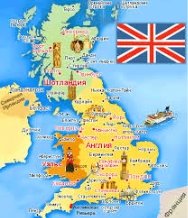
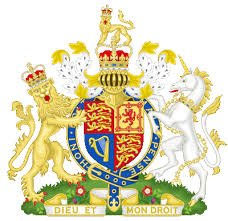
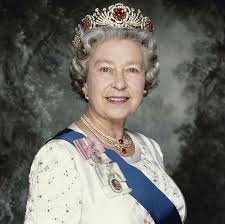

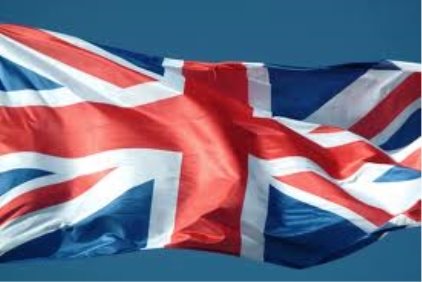
SS: 1) the lady is: the Queen of the United Kingdom of Great Britain and Northern Ireland. Her Majesty has an annual Christmas message; Britain is a parliamentary democracy with a constitutional monarch - Queen Elisabeth II as a head of state but the power of Her Majesty the Queen of the UK is limited by the British Parliament.
2) the music is: the anthem: “ The God Save the Queen”;
3) the flag of Britain is the Flag of the United Kingdom, known as the Union Jack or Union Flag)
T: All right, children. Would you like to see London? Why? What country do you think we are talking (the teacher opens the board to focus students’ attention on the subjects that have been written on the board)
SS:
T: The subject of our lesson is: London sightseeing tour. Today we are summarizing your knowledge about the capital of Great Britain – London and its landmarks; consolidate the lexis; revise using the Present and Past Tenses.
To begin with, I’ like you to watch the video. After that name as many symbols of the city as it possible.
(Students are watching the video)
T: What is London famous for?
(London is famous for its symbols, such as: the queen, Big Ben, red double decker buses, red telephone boxes, black cabs etc.)
T: That’s right. Would you like to see this beautiful city? So, would I. Unfortunately, we can’t go on a tour right now, but I think it will happen one day, indeed. But I have a surprise for you - we are setting off on a virtual trip. I booked a tour and received the letter from the Travel Agency. Here it is. Would anyone open and read it?
38 Riding House Street
London, Great Britain
Kharkiv Specialized School # 156,
9 A Haribaldi Street,
Kharkiv, Ukraine
Dear students,
We are glad to inform you to have a great chance to visit London. You will take part in England's fascinating history by visiting some of its most famous landmarks and have a medieval experiences walking through mysterious sites. Though it is a bus tour, nevertheless, you will have the opportunity to see the famous places sitting on a top floor of the double decker bus. The tour provides a guide, accommodation and flight in two directions. We wish you to spend time full of fun and emotions.
Your sincerely,
John Smith (General Manager)
Crystal Travel Agency
T: Of course, pupils, we will have limited time and won’t see the whole city but the brightest and the most striking sites. So, are you ready? Come on.
III.Main part of the lesson.
Language Development.
Task 1
T: Dear children, first look at the board and let’s revise the pronunciation of the following proper names. Repeat after me in better learning.
London Eye
Buckingham Palace
The Houses of Parliament
Tower Bridge
Tower of London -
St. Paul’s Cathedral
Westminster Abbey
Madame Tussauds
British Museum
Big Ben
Trafalgar Square
Hyde Park
Task2.
T: Great! While learning the theme, you knew a lot about the sights. I wonder if you know their location. So, come up to the teacher’s desk, take a picture, name it, stick on the board and mark the site on the map of London. (Great! Now I see that you know where the most remarkable and visited places are.)
Task3. Now, pupils, try to guess the sightseeing:
- Here is one of the largest libraries in the world(the British Library is in the British Museum)
- It boasts a collection of the biggest, tallest and rarest animals in the world
- Many tourists come here to see the Queen Victoria Memorial
- It has been used as a royal palace, an observatory, a state prison
- It can be raised to let ships pass through.
- It was destroyed by the Great Fire of London in 1666.
- Here is the seat of the British government
- It is the largest and the most popular area for free time activities in the open air
- The artists, writers, politicians and other celebrities have been created in wax there
- People see in the New Year there. A huge statue stands there.
- It offers the best views over the city.
- Almost all the kings and queens have been crowned there.
T: Well done, students. I hope you’ll use this information while travelling around London, talking about the famous sights.
IV. Developing dialogical speaking.
Group work.
Task 1.
T: Pupils, I wonder if you are ready to give the main facts about the sites I suggest you. To fulfill this task you should be divided into four teams. I’ll give you the handouts of the sights and short information about them with the missing words.
Pre-listening activity
First, skim the information, think and give your own predictions about the missing words.
While-listening activity
Listen to the tape recorder filling in the gaps.
Post-listening activity
Firstly, find out if your guesses were correct (one volunteer from the group). Secondly, one of the pupils will make the summary of each the text and represent it in front of the class as a guide (each group has got one site to present briefly). It can be possible to add some additional information to use it in language.
T: Children, if our guides coped with this kind of work quite well? Well, I agree with you.
|
Tower Bridge built between……...- 1894 by Sir Horace Jones • Steam……..…were used to raise the bridge so that……...could pass underneath • impressive twin Gothic ……….. |
The Tower of London built during the…..century by William the Conqueror • was the Royal Residence until the….century • has 19 towers • see the Crown Jewels in the…….. |
|
|
|
|
|
|
|
Big Ben installed in……. • the largest clock in Britain • the bell weighs …….tons the name “Big Ben” refers to the……., not the clock itself |
Buckingham Palace built in ….by the Duke of Buckingham • Victoria was the first…..to live there • Royal Standard is flying when the Queen is in Residence • every morning a changing of the guard ceremony………
|
Task2.
T: Now, pupils, you will be given the different descriptions of London’s landmarks. One site is for each group. The task is to collect specific information to know more about other attractions and fill in the table. First, look through them descriptions. Then, one representative from each group will ask a question. The answer should be written in the table. The questions are asked on a circle.
T: Now it’s time to play a virtual game. Watch the London Travel Video Guide.
Pretend that you work as a guide in London. Describe the following attractions.
T: Our travelling is coming to over, but I believe it’s not your last trip to London. Children, I know you have some feelings and emotions inside you. Could you share them, please? You can start with: (While travelling …./ being…) Also, use the phrases of expressing opinion. You can see them on the board.
SS:
- While travelling I got positive emotions and unforgettable impressions.
- While being in London I was deeply impressed by terrifying cultural heritage of the city.
- I always dreamt to visit Madam Tussard's Museum in Baker street and in this trip my dream has come true.
- I had a splendid time in London.
- In my opinion, London is the city which is worth seeing.
- As for me, everyone should feel the spirit of one of the oldest cities in Europe.
- I gained great cultural experience as I could see the world-famous historic delights.
- I was lucky to visit London and see some UNESCO world heritage sites.
VI. Making conclusion.
Pupils, I’d like you to pay attention on the motto of our lesson. You can read on the board:
“It’s better to see once, than hear about it for many times”
T: It’s a proverb. What does it mean?
S: It means that neither films or pictures nor stories can compare with travelling personally. It’s breathtaking to see and to fill the spirit of one of the oldest cities in Europe.
T: It’s true. I think the same. Today we have travelled around London to see a lot of city’s landmarks we have already learnt. I am sure you will share you unforgettable experiences and recommend your friends the landmarks which are worth seeing and for spending vacations in a best way. We have done lots of exercises. You were developing your listening, reading and speaking skills. You were active and I am satisfied with your answers indeed. However, some of you made some mistakes. So, I’d like you to revise the using and forming the Grammar Tenses; the structure of the English sentence; using Articles and prepositions; focus your attention on pronunciation of Proper Names. So, your marks for today are………
VII. Homework. Compose and write down the brochure or leaflet “London– Visitors Guide” to offer both tourist information as well as ideas and tips for planning holiday. You can see some leaflets examples on the board and sites you can use to fulfil the hometask.
VIII. Filling “Student Self Assessment Checklist”.
STUDENT SELF ASSESSMENT CHECKLIST
NAME: ____________________________________
FORM: __________
DATE: ___________
Evaluate your activity at the lesson:
|
Self assessment guiding points |
Excellent |
Very well |
OK |
Not very well |
Poor |
|
1. I can name London’s sites |
|
|
|
|
|
|
2. I understand information while listening |
|
|
|
|
|
|
3. I can use the Present and Past Tenses; Passive Voice while speaking |
|
|
|
|
|
|
4. I can understand the description of London’s sights |
|
|
|
|
|
|
5. I know the location of London’s attractions |
|
|
|
|
|
|
6. I can find out information through asking questions |
|
|
|
|
|
|
7. I can describe London’s places of interest |
|
|
|
|
|
|
8. I can share my travelling experience; emotions and feelings |
|
|
|
|
|
|
9. I know London’s symbols |
|
|
|
|
|
|
10. I liked the lesson |
|
|
|
|
|
|
11. I felt relaxed myself |
|
|
|
|
|
|
12. The atmosphere was friendly |
|
|
|
|
|
T: Now, I’d like to know how you can evaluate your own activity at the lesson.
Please, fill in the following student self assessment checklist. Tick – excellent -very well-ok- not very well- poor - to evaluate your own work at the lesson. I analyze your opinion and take into account. We will discuss them next lesson. So, the time is up. You may be free. See you tomorrow, children. Good bye.


про публікацію авторської розробки
Додати розробку


